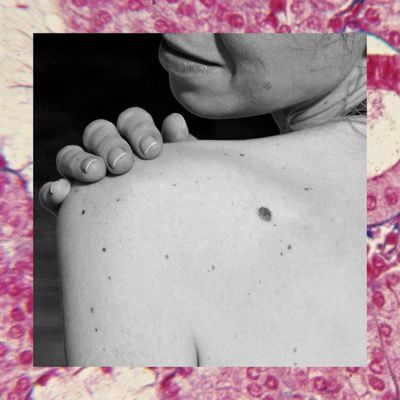
Welcome to Am I Dying, a column that hopes to save you from your late-night WebMD spiraling. You can email us your hypochondriac questions at amidying@nymag.com.
I live in constant fear of skin cancer. I tend to wear sunscreen and stay indoors whenever I can, but I still have no idea how to tell if any of the moles or freckles that adorn my body may actually be skin cancer or at least precancerous. How can you even tell? There’s this one mole on my right hand near my index finger that’s pretty light — it’s basically a slightly raised flat surface that is the color of milk coffee — and sometimes I just stare at it wondering if it is growing, cancerous, or maybe just a mole I was born with (who knows!!!). So basically … how can I tell if I might be in danger of skin cancer?
As a white person with an extremely delicate Western European background, I relate to this worry. In fact, at age 31, I have already had two precancerous moles removed, and have thus been condemned to annual skin-cancer screenings for the rest of my life. One was on my hairline (!), and even though my dermatologist told me my hair would grow back, it did not, and I had to switch the side I parted my hair on. (Sorry, not trying to traumatize you further.) The other was on the back of my calf, and I still have a mark there too.
Here’s the thing: what precancerous means is actually kind of controversial. Says Dr. Jennifer Stein, a dermatologist at NYU Langone Health, “When you biopsy irregular moles under the microscope, they can have some features of a melanoma, but not actually be a melanoma. This doesn’t necessarily mean that they’re on their way to becoming a melanoma.” That said, your dermatologist will treat a precancerous mole as a marker for increased risk, which means that having one will set you up for lifelong annual visits like mine.
But before you rush off to the doctor in a panic, there are some general guidelines you can use to assess the risk of the mole in question. Conveniently, these warning signs come in the form of pneumonic device, which Stein refers to as the “ABCDEs of melanoma,” probably one of the less fun alphabets around. Here’s what you should look for in a mole:
A is Asymmetry, meaning one side looks different from the other.
B stands for Border, as in, an irregular or noticeable border around the mole.
C stands for Color (even color is normal, whereas many colors are not).
D stands for Diameter, or size. “When it’s bigger than a pencil eraser you start to get worried,” says Stein.
E stands for Evolving, or changing. “If you’ve always had a mole that looked a certain way, and then it starts to grow or change colors or starts to bleed, or you’re worried about it for any reason, it’s always best to get it checked,” says Stein.
If your mole meets a few of these criteria, it’s probably worth getting it checked out. Skin biopsies are easily done in a clinic, says Stein, and not always necessary – oftentimes, a dermatologist will be able to tell if your mole looks potentially cancerous just by looking at it. In part, this is done by comparison: If the mole in question looks like the rest of your moles, it’s probably fine. It’s when there’s an outlier that you start to worry. Stein calls this the “ugly duckling rule.”
“For some people, all the moles on their body are very light. If one of those moles is very dark, that’s their ugly duckling,” says Stein. “Often for people who are darker skinned, their moles will be dark. So a dark mole for that person isn’t so worrisome. Say that person all of a sudden has this bright pink spot — that might be their ugly duckling. You want to compare each mole to the rest of the moles on your body, and make sure it fits in with the rest of the family.”
Stein adds that if you’re pale, red-headed, freckly, and/or have a history of using tanning beds, you should probably get a screening once a year, just to be safe. Take it from someone who’s been through at least six such screenings: at least they’re painless, and over with pretty quickly, and it’ll feel like a deed well done when all your freckles and moles pass muster.





